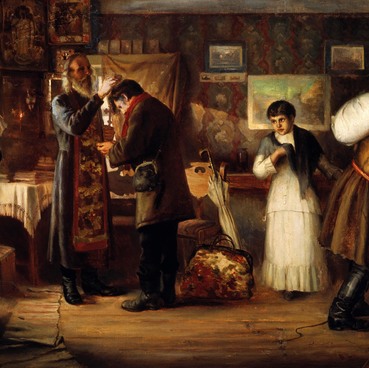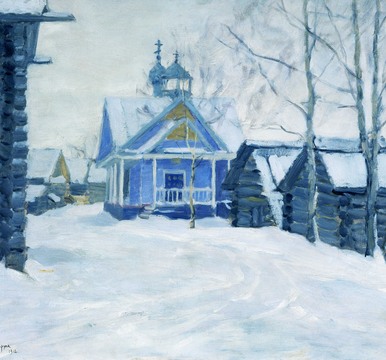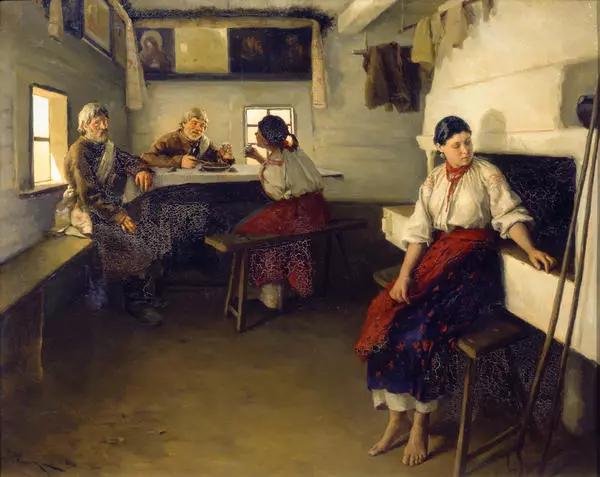Russian-Ukrainian genre artist Nikolai Pimonenko was born near Kiev in 1862 into a petty-bourgeois family, his father was engaged in woodcarving and owned an icon painting workshop. He received his first drawing lessons at the local icon-painting school, where Nikolay Murashko, the head of the Kiev drawing school, noticed his exceptional abilities. He convinced the local landowner and philanthropist to pay for Pimonenko’s education - and already in 1882 he graduated with brilliance.
In the same year, Pimonenko entered the St. Petersburg Academy of Arts, where he began to study in the class of landscape painter Vladimir Orlovsky. He received three silver medals for excellent study, but the northern climate was bad for the artist’s health, and in 1884 he had to return to his homeland. There he worked as a drawing teacher for some time, and later, together with other artists, organized the Kiev Art College.
In the 1880s, Pimonenko was going through an intense creative search and participated in various exhibitions with various paintings. By the end of the decade, the main theme of his art was the image of the everyday life of the Ukrainian village. He represented the life of ordinary Ukrainians in a poetic vein, often on his canvas, genre scenes were combined with lyrical landscape painting – in particular, the work The Last Ray that was completed in 1900.
In this picture, Pimonenko highlighted the unpretentious rural motif with spectacular glow of the setting sun. In the foreground, on a village street, a boy and a girl are chasing geese. Behind the tops of dark trees, a bright orange-crimson sunset is depicted, its light is reflected in the stream, leaves glare on the white walls of the peasant’s house, gilds the heads of the children - in this work, the artist fully demonstrated his mastery of lighting effects. Also here, the theme of the unity of nature and man has been brought almost to a symbol.
By the beginning of the 20th century, Pimonenko was a world famous artist: his paintings were exhibited in major European cities (one of his works was even purchased by Louvre), he was accepted as a member of the Association of Wanderers, and the Academy of Arts granted him the title of academician of painting. In 1912, after a protracted illness, Pimonenko died at the age of 50.
In the same year, Pimonenko entered the St. Petersburg Academy of Arts, where he began to study in the class of landscape painter Vladimir Orlovsky. He received three silver medals for excellent study, but the northern climate was bad for the artist’s health, and in 1884 he had to return to his homeland. There he worked as a drawing teacher for some time, and later, together with other artists, organized the Kiev Art College.
In the 1880s, Pimonenko was going through an intense creative search and participated in various exhibitions with various paintings. By the end of the decade, the main theme of his art was the image of the everyday life of the Ukrainian village. He represented the life of ordinary Ukrainians in a poetic vein, often on his canvas, genre scenes were combined with lyrical landscape painting – in particular, the work The Last Ray that was completed in 1900.
In this picture, Pimonenko highlighted the unpretentious rural motif with spectacular glow of the setting sun. In the foreground, on a village street, a boy and a girl are chasing geese. Behind the tops of dark trees, a bright orange-crimson sunset is depicted, its light is reflected in the stream, leaves glare on the white walls of the peasant’s house, gilds the heads of the children - in this work, the artist fully demonstrated his mastery of lighting effects. Also here, the theme of the unity of nature and man has been brought almost to a symbol.
By the beginning of the 20th century, Pimonenko was a world famous artist: his paintings were exhibited in major European cities (one of his works was even purchased by Louvre), he was accepted as a member of the Association of Wanderers, and the Academy of Arts granted him the title of academician of painting. In 1912, after a protracted illness, Pimonenko died at the age of 50.





